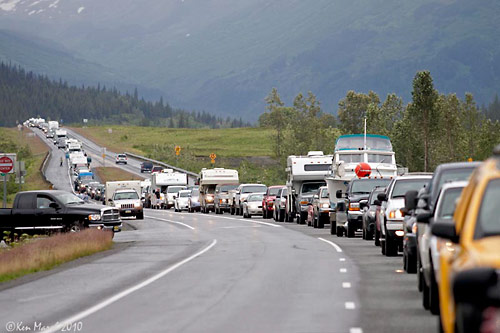Agencies Ask Motorists to Avoid “Animal Jams,” Roadside Viewing Hazards
- ADF&G Press Release
Cora Campbell, Commissioner
P.O. Box 115526
Juneau, Alaska 99811
Phone: (907) 465-6166 - Fax: (907) 465-2332
Press Release: May 15, 2014
Regional Contacts:
Riley Woodford, Juneau, (907) 465-4256
Cathy Harms, Fairbanks, (907) 459-7231
Ken Marsh, Anchorage, (907) 267-2892
Agencies Ask Motorists to Avoid “Animal Jams,” Roadside Viewing Hazards
(Statewide) - No Alaska road trip is complete without a wildlife sighting or two, but the Alaska Department of Fish and Game and the Department of Transportation and Public Facilities are asking motorists who stop for pictures or a closer look to please use care to avoid creating driving hazards and “animal jams.”
Traffic along Alaska’s highways increases each spring and summer as campers, anglers, visitors and sightseers hit the roads to enjoy the state’s outdoors. Along the way, bears, moose, Dall sheep and other wildlife may appear, inspiring sudden stops by viewers hoping to take pictures or simply get a long look at what for many is a rare sight. Public safety issues arise and traffic backs up when motorists fail to pull off roads completely, or when passengers step out of vehicles into oncoming lanes to view or take pictures.
Currently in Southeast, black bears are causing animal jams and safety concerns for drivers. “Emerging vegetation draws bears to roadsides and there are reports that cars are pulling over – but not far enough – and people are popping out to watch bears by the road,” says Juneau-based Alaska Department of Fish and Game information officer Riley Woodford.
Similar issues occur on road systems statewide. In the Southcentral region, Dall sheep, moose, bears and even beluga whales distract drivers along the Seward Highway south of Anchorage. Motorists in the Interior may encounter caribou, moose, bears, wolves and even bison.
Drivers are asked to stay alert when approaching and driving by an animal jam. Pedestrians and wildlife may suddenly appear from behind parked vehicles; motorists can unexpectedly re-enter the highway; and oncoming traffic may be distracted by the roadside commotion.
“Please focus on the road and be alert of your surroundings. If you choose to pull over, allow for a safe braking distance between you and other vehicles and use proper turn signals and emergency lights to notify other drivers of your intentions,” said Mike Coffey, Chief of Statewide Maintenance and Operations for the Department of Transportation and Public Facilities.
No matter where in Alaska you’re driving, be particularly alert around hills and corners that create blind spots to oncoming traffic. “It's exciting to see a bear,” says Woodford, “but think about where you have stopped. Can you safely get back into traffic? Will a car come around a corner or over a rise and suddenly be on you?”
If you do find a safe place to stop, avoid approaching wildlife too closely. Bears and moose may feel threatened, particularly those with young, posing a danger to viewers, or become startled and run into traffic.
###

